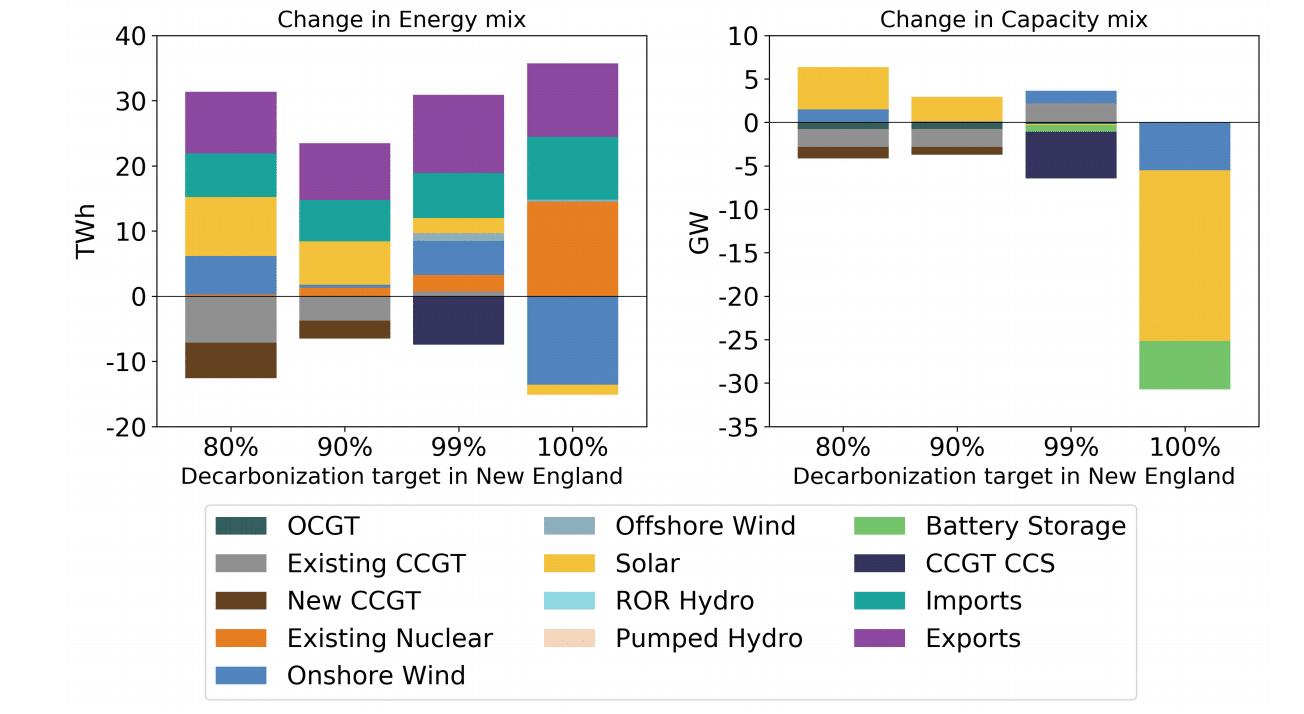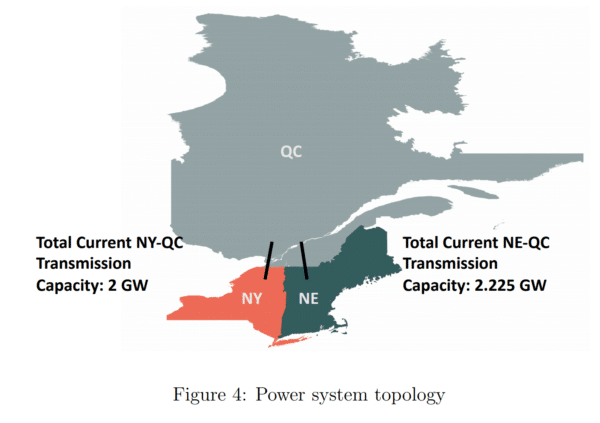Researchers, Emil Dimanchev, Joshua Hodge, and John Parsons, at the MIT Center for Energy and Environmental Policy Research have published a paper positing that a 4 GW powerline connecting Quebec hydroelectric sources with the New England or New York power grids could save the regions $2.4 and $3 billion a year in finance costs.
As the regions reach for 100% clean energy, the paper suggests that roughly 90 GW and 123 GW of wind, solar, energy storage and other capacity will be needed for either the New England or New York ISO power grids, respectively. Research has consistently shown that cleaning the first 80% of electricity generation is much easier than the last 20% – and this document is no different.
However, adding a powerlines from Canada lowers the infrastructure needs of either by a third and a quarter in New England and New York as the 100% power grid fully blossoms in 2050. The solar power saved in New England alone, approximately 25 GWac worth, would be worth tens of billions in saved deployments over the decades.

The paper reminds us that as the decarbonization levels increase, the costs to build infrastructure due to the intermittent nature of wind and solar increases precipitously. Compared to today’s existing transmission infrastructure, the 4 GW plan in the 80% to 90% decarbonisation scenarios mean savings are in the hundredths of a cent per kWh – totaling up to $100 million. However, as 99% and 100% clean energy goal is hit, these savings increase by 15-20X, reaching $913 million to $2.4 billion/year in New England. These values, worth about 0.3-0.7¢/kWh, represent a reduction in power system costs of 13% and 24%.

The more optimized power grid, with very little wind and solar that is ‘rarely used’, also lowers renewable curtailment by 93% — 44 TWh of electricity per year. Based on 2018 New England wholesale rates of ~4.4¢/kWh, this represents almost $2 billion in electricity annually for just the New England region.
The authors suggest that the hydroelectric facilities won’t change size, but instead their operating patterns. The changes exist on seasonal, and daily levels. For instance, as New England approaches 100% decarbonization, the hydro facilities must fully account for the heavy daytime solar generation. Seasonally, hydro output shifts toward the summer months, increasing by about 10% in August in the 100% decarbonization scenario. As the year moves into the fall and New England winter, hydro needs decrease as wind output increases.

Caveats must be inserted into this article, as in the paper the authors modeled each regional scenario on its own as it individually moved toward 100% clean energy. However, when asked by pv magazine USA whether both regions could concurrently move toward 100% with their own 4 GW powerlines, author Emil Dimanchev said:
“Quebec has the potential to expand transmission to both regions according to our model. How much exactly, we’re not sure, but we tested a scenario where both New England and New York decarbonize by 100% and both build 4 GW of new transmission to Quebec. We see savings that are comparable to our individual scenarios.”
Of course, not to throw…fire…onto the idea, but New England isn’t exactly ready to build transmission. So while this document shows a clear path and significant economic benefit, the complexities of local politics will probably continue to carry the day on the topic.
This content is protected by copyright and may not be reused. If you want to cooperate with us and would like to reuse some of our content, please contact: editors@pv-magazine.com.









Building distribution infrastructure will be necessary sooner or later, is not a local mid-voltage micro-grid more energy efficient than sending HV electricity hundreds of miles, then when the power gets to the destination, the common practice of step down transformers for domestic use begins and for every transformer step one (can) lose from 2% to 3% of the power per step. Micro-grids of solar PV and or wind generation with energy storage could retrieve at least 10% efficiency by eliminating some transformer losses along the grid. Distributed generation with grid boundary interconnects may have a larger bang for the buck. Instead of the centralized generation facility, distributed over power corridors, a new model of distributed smaller micro-grids that can access a Northern region HV D.C. power connector, a Middle region HV D.C. power connector and a South region HV D.C. power connector.